
The Royal Horticultural Society (RHS), founded in 1804 as the Horticultural Society of London, is the UK's leading gardening charity.

Pinus parviflora, also known as five-needle pine, Ulleungdo white pine, or Japanese white pine, is a pine in the white pine group, Pinus subgenus Strobus, native to Korea and Japan.
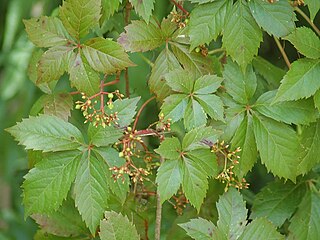
Parthenocissus quinquefolia, known as Virginia creeper, Victoria creeper, five-leaved ivy, or five-finger, is a species of flowering vine in the grape family, Vitaceae. It is native to eastern and central North America, from southeastern Canada and the eastern United States west to Manitoba and Utah, and south to eastern Mexico and Guatemala.

Hyacinthus orientalis, the common hyacinth, garden hyacinth or Dutch hyacinth, is a species of flowering plant in the family Asparagaceae, subfamily Scilloideae, native to southwestern Asia, southern and central Turkey, northwestern Syria, Lebanon and northern Israel. It was introduced to Europe in the 16th century. It is widely cultivated everywhere in the temperate world for its strongly fragrant flowers which appear exceptionally early in the season, and frequently forced to flower at Christmas time.

Erica vagans, the Cornish heath or wandering heath, is a species of flowering plant in the family Ericaceae, native to Ireland, Cornwall, western France and Spain. It is a vigorous, spreading, evergreen heather reaching 75 cm (30 in) tall and wide, with pink flowers borne in racemes 14 cm (6 in) long in summer and autumn. The Latin specific epithet vagans literally means "wandering"; in this context it means "widely distributed".

Erica cinerea, the bell heather, is a species of flowering plant in the heath family Ericaceae, native to western and central Europe.
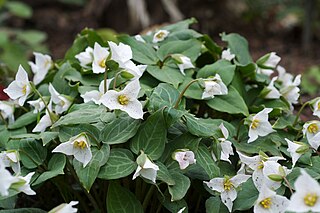
Pseudotrillium is a monotypic genus of flowering plant in the family Melanthiaceae. Its sole species, Pseudotrillium rivale, is commonly known as the brook wakerobin. It is endemic to the Siskiyou Mountains of southern Oregon and northern California. The Latin specific epithet rivale means “growing by streams”, with reference to a preferred habitat.

Sempervivum arachnoideum, the cobweb house-leek, is a species of flowering plant in the family Crassulaceae, native to European mountains, in the Alps, Apennines and Carpathians. Growing to 8 cm (3 in) tall by 30 cm (12 in) wide, it is a rosette-forming succulent perennial, valued in cultivation for its ability to colonise hot, dry areas via offsets.

Cardamine pentaphyllos, the five-leaflet bitter-cress or showy toothwort, is a flowering plant in the family Brassicaceae, native to Western and Central Europe in Slovenia and Croatia. It is an herbaceous perennial, growing to 30–50 cm (12–20 in), with palmate leaves and racemes of purple, pink or white flowers in late Spring and early Summer.

Kalmia angustifolia is a flowering shrub in the family Ericaceae, commonly known as sheep laurel. It is distributed in eastern North America from Ontario and Quebec south to Virginia. It grows commonly in dry habitats in the boreal forest, and may become dominant over large areas after fire or logging. Like many plant species of infertile habitats it has evergreen leaves and mycorrhizal associations with fungi. It is also found in drier area of peat bogs.

Veronicastrum virginicum, or Culver's root, is a species of flowering plant in the plantain family, Plantaginaceae. It is native to the eastern United States and south-eastern Canada. Growing to 200 cm (79 in) tall by 45 cm (18 in) broad, it is an erect herbaceous perennial with slender racemes of white or occasionally pink or purple flowers in summer.

Phlox subulata the creeping phlox, moss phlox, moss pink or mountain phlox, is a species of flowering plant in the family Polemoniaceae, native to eastern and central USA, and widely cultivated.

Phlomis fruticosa, the Jerusalem sage, is a species of flowering plant in the family Lamiaceae, native to Albania, Cyprus, Greece, Italy, Turkey, and countries of the former Yugoslavia.

Salvia fulgens, the Cardinal sage or Mexican scarlet sage, is a species of flowering plant native to the Mexican mountains adjacent to the state of Puebla, growing at 8,700-11,000 ft elevation. It prefers the edge of oak and coniferous woodlands, especially in clearings of Abies religiosa. The mountains receive fog and rain nearly year-round.
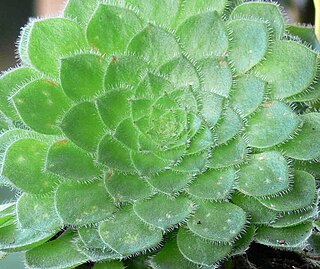
Aeonium tabuliforme, the flat-topped aeonium or saucer plant, is a species of succulent plant in the family Crassulaceae, native and endemic to Tenerife in the Canary Islands. It is low-growing, typically reaching about 5 cm high but up to 45 cm in diameter. It grows on moist, north-facing cliffs and ledges at low altitude. A mass of fleshy, hairy, bright green leaves in flat rosettes is produced on short unbranched stems, often on vertical surfaces. This species is short-lived and dies after flowering. Plants often take 3-4 years to flower, at which point they produce a tall raceme of yellow flowers.
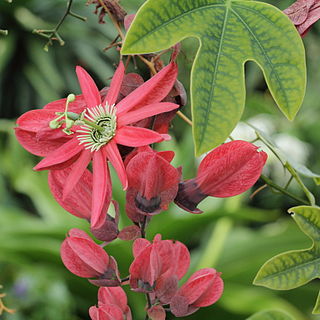
Passiflora racemosa, the red passion flower, is a species of flowering plant in the family Passifloraceae, native to Brazil. It is an evergreen climber growing to 5 m (16 ft), with simple or 3-lobed leaves to 10 cm (4 in) long, and vivid red flowers borne in summer. The flowers are 12 cm (5 in) in diameter, with purple and white coronas. They are followed by oblong green fruits.
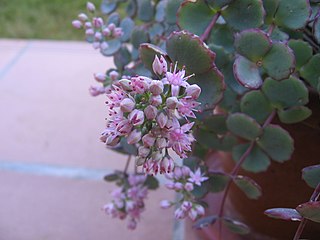
Hylotelephium sieboldii, the October stonecrop, Siebold's stonecrop, Siebold's sedum or October daphne, is a species of flowering plant in the family Crassulaceae, native to Japan. Growing to 10 cm (4 in) high by 20 cm (8 in) wide, this trailing deciduous perennial produces its round glaucous leaves in whorls of 3 around the delicate stems. The hot-pink flowers appear in autumn (fall).

Viscaria vulgaris, the sticky catchfly or clammy campion, is a flowering plant in the family Caryophyllaceae.

Primula prolifera, the candelabra primrose or glory of the bog, is a flowering plant in the family Primulaceae. Its botanical name is currently unresolved.

Cardamine bulbifera, known as coralroot bittercress or coral root, is a species of flowering plant in the family Brassicaceae. It is a perennial with upright, mostly unbranched, stems to 70 cm (28 in) tall, and leaves made up of between three and 13 leaflets. The flowers have petals that are 10–15 mm (0.4–0.6 in) long collected in corymbose few-flowered racemes and are generally light purple, pink or almost white. It is found in damp places.




















